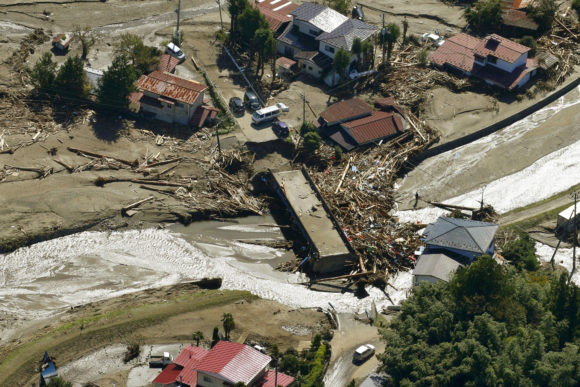Typhoon Hagibis is likely to become one of 2019’s costliest events, with economic costs of more than US$10 billion and insured losses minimally in the billions, according to Aon’s monthly catastrophe report.
The storm made landfall in Japan’s Iza Peninsula on Oct. 12 before it swept through the greater Tokyo metro region. At least 95 people were killed, and more than 93,250 structures were damaged or destroyed, said Aon’s Global Catastrophe Recap October 2019 report, which is compiled by Aon’s catastrophe modeling team, Impact Forecasting.
The report then went on to detail the losses from the wildfires that raged in California during the month, exacerbated by strong Diablo & Santa Ana winds, although their impact was less than 2017/18 fires.
California’s most destructive fires during the period Oct. 10-17 included the Saddle Ridge Fire (Los Angeles County) and Sandalwood Fire (Riverside County), which are expected to bring economic damage in excess of US$100 million, with most of the losses covered by insurance.
Extremely critical wildfire conditions also brought numerous ignitions across Northern and Southern California from Oct. 23 into early November, said the report. The most significant fires included the Kincade Fire in Sonoma County with 374 structures destroyed; the Tick Fire in Los Angeles County with 29 structures affected; the Getty Fire in Los Angeles County with 10; the Hillside Fire in San Bernardino County with six; the Maria Fire in Ventura County with four, and the Easy Fire in Ventura County with two structures destroyed. Total economic and insured losses were expected to reach into the hundreds of millions of dollars, the report said.
Also in the U.S. during October, a severe weather outbreak spawned nearly 30 tornado touchdowns, damaging winds, and large hail across the Plains and Southeast on Oct. 20-21 when at least four people were killed. Most impacts were recorded in Texas, where a confirmed EF3 tornado with up to 140 mph (220 kph) winds struck several neighborhoods in North Dallas. Further tornado and storm-related impacts were cited in parts of Arkansas, Oklahoma, Missouri, Louisiana, and Tennessee. Economic and insured losses were likely to reach into the hundreds of millions of dollars, perhaps higher.
“Vulnerabilities around tropical cyclones, flooding, and wildfires were again exposed during October. Events such as Typhoon Hagibis in Japan and wildfires in California served as a reminder of the repetitive, or clustering, nature of certain perils on a year-to-year basis that can often be hard to predict,” said Steve Bowen, director and meteorologist within Aon’s Impact Forecasting team.
“With ample exposure located in high-risk locations all around the world, it becomes increasingly important to utilize the latest tools available to better prepare for future weather and climate-related scenarios in both mature and developing markets,” he added.
Other global natural catastrophe events during October include:
- Hurricane Lorenzo, the easternmost Category 5 Atlantic Hurricane on record, affected the Azores on Oct. 2 as a Category 1 storm. The Portuguese government estimated damage costs at €330 million (US$367 million), primarily attributed to port infrastructure.
- Parts of Western, Central and Eastern Africa were affected by seasonal flooding throughout October. The events brought significant humanitarian impact, affecting hundreds of thousands of people. The combined death toll from October flooding was at least 208.
- A weakened Typhoon Mitag made landfall in eastern China’s Zhejiang Province (Zhoushan City) on Oct. 1 as a tropical storm, and a second landfall in South Korea on Oct. 2. Heavy rains caused flooding and landslides in South Korea, where at least 14 people were confirmed dead or missing and more than 1,000 properties were inundated. In Zhoushan, China, the storm caused three fatalities. Total economic losses amounted to at least US$816 million, including US$553 million in South Korea and US$263 million in China.
- An active bushfire season in September and October saw numerous fires burn across parts of Queensland and New South Wales as much of Eastern Australia continued to deal with severe drought conditions. The fires destroyed dozens of structures and the Insurance Council of Australia declared separate insurance catastrophe events in each state. Total economic and insured losses from the bushfires were expected into the tens of millions of dollars.
Source: Aon Impact Forecasting
Topics California Catastrophe USA Natural Disasters Profit Loss Wildfire Flood China Aon Japan
Was this article valuable?
Here are more articles you may enjoy.



 Uncertainty Keeps Prices Up; No Prior-Year Loss Development: Travelers
Uncertainty Keeps Prices Up; No Prior-Year Loss Development: Travelers  Why New York’s Attorney General Objects to Trump’s Bond Insurer
Why New York’s Attorney General Objects to Trump’s Bond Insurer  Allstate Reports $731M in Q1 Pretax Catastrophe Losses
Allstate Reports $731M in Q1 Pretax Catastrophe Losses  Chubb to Acquire MGA Healthy Paws From Aon
Chubb to Acquire MGA Healthy Paws From Aon 

